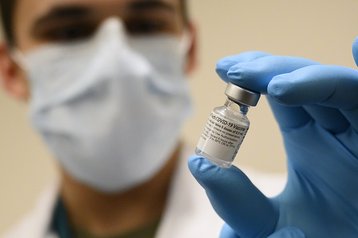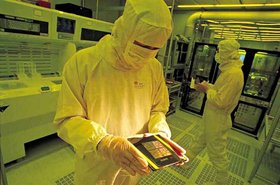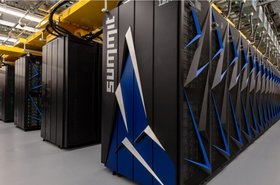Several US states plan to offer some level of vaccination priority to communications and IT staff who have been deemed essential workers during the Covid-19 pandemic.
Arkansas, California, District of Columbia, Illinois, Nevada, and Virginia will vaccinate IT workers ahead of a general rollout of the vaccine, although they will come behind the oldest and most vulnerable recipients, as well as some other frontline workers.
Different plans across the country
It's important to note that each state's vaccine plan is subject to change, given the nature of a potentially mutating virus and the uncertainty of the political environment. But, in their most recent vaccination plans, each state said that they would include communications and IT workers in a list of early vaccine beneficiaries.
Ahead of a general release, each state plans several smaller phases that target individuals who are at risk, either due to health and age reasons or because their job forces them to come into contact with people.
Arkansas
The south central state plans three phases: 1-A, 1-B, and 1-C.
Phase 1-A will vaccinate at-risk healthcare workers, first responders, and essential government leaders.
Then, Phase 1-B will innoculate persons age 70 and older; teachers, school staff, childcare workers; food and agriculture workers; firefighters and police not included in Phase 1-A; manufacturing workers; grocery workers; public transit personnel; US Postal Service; essential government workers.
Finally, in Phase 1-C persons age 65 and older; persons ages 16-64 with chronic conditions putting them at risk for severe Covid-19 illness; water and wastewater workers; transportation and logistics workers; food service workers; shelter and housing workers; finance; IT and communications; energy and utilities; public safety and public health workers; and media.
California
The most popular US state is still working on its priority list, and is currently debating how to subprioritize those in the first of its four phases.
First is Phase 1A, which covers healthcare or long-term care workers and residents of assisted living facilities and similar long-term care facilities for the elderly or infirm.
Next up is the confusingly named 'Phase 1B, Tier 1,' which will bring the vaccine to those age 75 and older. It will also target those at risk of exposure due to their jobs in education, childcare, emergency services, and food and agriculture.
Phase 1B then gets its Tier 2, covering ages 65-74; those at risk of exposure because of work in transportation and logistics; industrial, commercial, residential, and sheltering facilities and services; critical manufacturing. Also covered are the incarcerated and homeless.
The final phase is 1C, which will vaccinate those age 50-64. Individuals between 16-64 that have an underlying health condition or disability which increases their risk will also be vaccinated. As will those at risk of exposure due to working in the fields of water and wastewater; defense; energy; chemical and hazardous materials; IT and communications; financial services; government operations, and community-based essential functions.
District of Columbia
The US capital may lack statehood and an effective police presence, but that doesn't mean it lacks a Covid-19 vaccination plan.
Phase 1A will primarily cover healthcare workers and those being treated. It will also vaccinate residents of skilled nursing facilities, assisted living facilities, and longer-term psychiatry inpatients.
Then Phase 1B will innoculate residents who are 75 and older, as well as law enforcement, public safety, teachers and staff, childcare providers, grocery store workers, community outreach workers, correction workers, public transit workers, manufacturing, US postal service workers, and agriculture workers.
Phase 1C will then vaccinate transportation and logistics, food service, housing construction, government essential workers, finance, IT and communications, energy, media, legal, water, or other sectors; residents 65 and older and those with high-risk medical conditions.
Illinois
The midwestern state will also have a three-phase vaccine release.
Phase 1a will target healthcare workers and long-term care facility residents.
Next, Phase 1b covers people age 75 and older essential frontline workers
Finally, Phase 1c will innoculate adults ages 65-74; adults ages 16-64 with high-risk medical conditions; workers in transportation & logistics, water & wastewater, food service, shelter and housing, finance, IT and communications, energy, legal, media, and public safety, and public health workers.
Nevada
The state best known for its love of gambling is the only one to not put communications workers at the bottom of the priority list, slapping them in the middle of its four phases. Communications workers appear to be ahead of some people with underlying medical conditions
Tier 1 will roll the vaccine out to the following individuals - in order of priority: General medical and surgical hospital staff; long-term care facility staff and residents; EMS; frontline public health workers and volunteers; laboratory workers; pharmacists and pharmacy techs; outpatient and home health providers; Department of Corrections staff; law enforcement and public safety; deployed and mission-critical personnel who play an essential role in national security; state and local emergency operations personnel.
Then Tier 2 will cover (again, in order of priority) education and childcare staff; state higher education system faculty; essential public transportation; agriculture and food processing; essential retail workers; logistics and supply chain; utilities and communications infrastructure; NDOT and local emergency road personnel; community support/social services; airport operations; depository credit institution workforce; mortuary services; remaining public health workforce; additional critical infrastructure; Department of Corrections inmates.
Next up is Tier 3, still in order of priority, which plans to vaccinate transitional housing for released offenders; homeless individuals; people who are definitely at increased risk due to underlying medical conditions; people who may be at increased risk due to underlying medical conditions; adults aged 65 and older; and any remaining NSHE staff.
Finally, Tier 4 covers healthy adults ages 16-64.
Virginia
Home to the largest number of data centers in the US and the world, Virginia hasn't forgotten about its communications workers, adding them to its phased release.
Phase 1a will cover healthcare personnel.
Phase 1b then plans to vaccinate essential workers in the following order of priority: police, fire, and hazmat; corrections and homeless shelter workers; childcare/k-12 teachers/staff; food and agriculture; manufacturing; grocery store workers; public transit workers; public and private mail carriers; persons age 75 and older; persons living in shelters, correctional facilities, and migrant labor camps.
Then in Phase 1c, they will vaccinate essential workers in this order of priority: energy; water and wastewater; housing/construction; food service; transportation and logistics; institutions of higher education faculty/staff; finance; IT and communications; media; legal services; public safety (engineers); other public health workers; officials needed to maintain continuity of government; persons age 65 and older; those ages 16-64 with high-risk underlying medical conditions.
Other states
Similar plans are still being drafted by some states, while others have said that they plan to vaccinate essential workers, or in the case of Wyoming "critical infrastructure workforce." DCD readers in those states are recommended to work with their employer and healthcare providers to see if they are included in such definitions.




